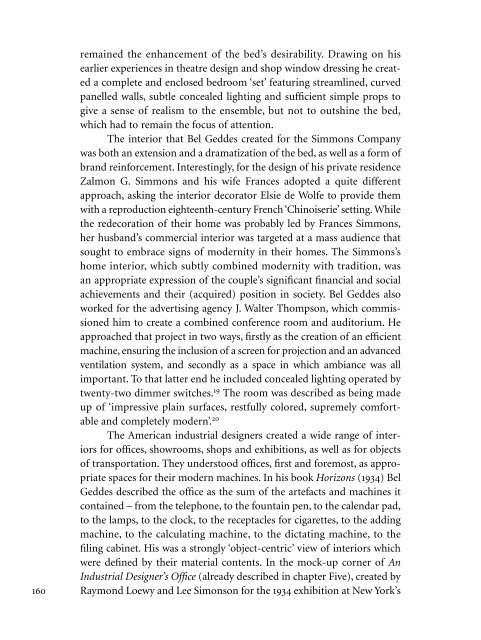You also want an ePaper? Increase the reach of your titles
YUMPU automatically turns print PDFs into web optimized ePapers that Google loves.
160<br />
remained the enhancement of the bed’s desirability. Drawing on his<br />
earlier experiences in theatre design and shop window dressing he created<br />
a complete and enclosed bedroom ‘set’ featuring streamlined, curved<br />
panelled walls, subtle concealed lighting and sufficient simple props to<br />
give a sense of realism to the ensemble, but not to outshine the bed,<br />
which had to remain the focus of attention.<br />
<strong>The</strong> interior that Bel Geddes created for the Simmons Company<br />
was both an extension and a dramatization of the bed, as well as a form of<br />
brand reinforcement. Interestingly, for the design of his private residence<br />
Zalmon G. Simmons and his wife Frances adopted a quite different<br />
approach, asking the interior decorator Elsie de Wolfe to provide them<br />
with a reproduction eighteenth-century French ‘Chinoiserie’ setting. While<br />
the redecoration of their home was probably led by Frances Simmons,<br />
her husband’s commercial interior was targeted at a mass audience that<br />
sought to embrace signs of modernity in their homes. <strong>The</strong> Simmons’s<br />
home interior, which subtly combined modernity with tradition, was<br />
an appropriate expression of the couple’s significant financial and social<br />
achievements and their (acquired) position in society. Bel Geddes also<br />
worked for the advertising agency J. Walter Thompson, which commissioned<br />
him to create a combined conference room and auditorium. He<br />
approached that project in two ways, firstly as the creation of an efficient<br />
machine, ensuring the inclusion of a screen for projection and an advanced<br />
ventilation system, and secondly as a space in which ambiance was all<br />
important. To that latter end he included concealed lighting operated by<br />
twenty-two dimmer switches. 19 <strong>The</strong> room was described as being made<br />
up of ‘impressive plain surfaces, restfully colored, supremely comfortable<br />
and completely modern’. 20<br />
<strong>The</strong> American industrial designers created a wide range of inter -<br />
iors for offices, showrooms, shops and exhibitions, as well as for objects<br />
of transportation. <strong>The</strong>y understood offices, first and foremost, as appropriate<br />
spaces for their modern machines. In his book Horizons (1934) Bel<br />
Geddes described the office as the sum of the artefacts and machines it<br />
contained – from the telephone, to the fountain pen, to the calendar pad,<br />
to the lamps, to the clock, to the receptacles for cigarettes, to the adding<br />
machine, to the calculating machine, to the dictating machine, to the<br />
filing cabinet. His was a strongly ‘object-centric’ view of interiors which<br />
were defined by their material contents. In the mock-up corner of An<br />
Industrial Designer’s Office (already described in chapter Five), created by<br />
Raymond Loewy and Lee Simonson for the 1934 exhibition at New York’s



